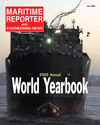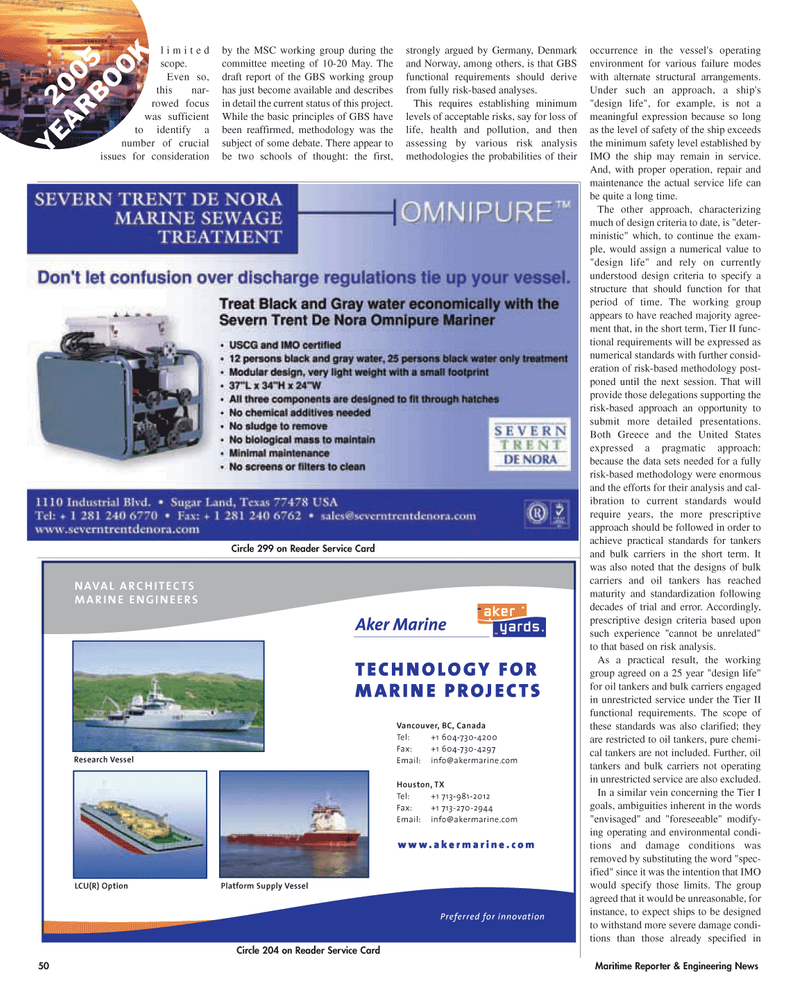
Page 50: of Maritime Reporter Magazine (June 2005)
Annual World Yearbook
Read this page in Pdf, Flash or Html5 edition of June 2005 Maritime Reporter Magazine
50 Maritime Reporter & Engineering News limited scope.
Even so, this nar- rowed focus was sufficient to identify a number of crucial issues for consideration by the MSC working group during the committee meeting of 10-20 May. The draft report of the GBS working group has just become available and describes in detail the current status of this project.
While the basic principles of GBS have been reaffirmed, methodology was the subject of some debate. There appear to be two schools of thought: the first, strongly argued by Germany, Denmark and Norway, among others, is that GBS functional requirements should derive from fully risk-based analyses.
This requires establishing minimum levels of acceptable risks, say for loss of life, health and pollution, and then assessing by various risk analysis methodologies the probabilities of their occurrence in the vessel's operating environment for various failure modes with alternate structural arrangements.
Under such an approach, a ship's "design life", for example, is not a meaningful expression because so long as the level of safety of the ship exceeds the minimum safety level established by
IMO the ship may remain in service.
And, with proper operation, repair and maintenance the actual service life can be quite a long time.
The other approach, characterizing much of design criteria to date, is "deter- ministic" which, to continue the exam- ple, would assign a numerical value to "design life" and rely on currently understood design criteria to specify a structure that should function for that period of time. The working group appears to have reached majority agree- ment that, in the short term, Tier II func- tional requirements will be expressed as numerical standards with further consid- eration of risk-based methodology post- poned until the next session. That will provide those delegations supporting the risk-based approach an opportunity to submit more detailed presentations.
Both Greece and the United States expressed a pragmatic approach: because the data sets needed for a fully risk-based methodology were enormous and the efforts for their analysis and cal- ibration to current standards would require years, the more prescriptive approach should be followed in order to achieve practical standards for tankers and bulk carriers in the short term. It was also noted that the designs of bulk carriers and oil tankers has reached maturity and standardization following decades of trial and error. Accordingly, prescriptive design criteria based upon such experience "cannot be unrelated" to that based on risk analysis.
As a practical result, the working group agreed on a 25 year "design life" for oil tankers and bulk carriers engaged in unrestricted service under the Tier II functional requirements. The scope of these standards was also clarified; they are restricted to oil tankers, pure chemi- cal tankers are not included. Further, oil tankers and bulk carriers not operating in unrestricted service are also excluded.
In a similar vein concerning the Tier I goals, ambiguities inherent in the words "envisaged" and "foreseeable" modify- ing operating and environmental condi- tions and damage conditions was removed by substituting the word "spec- ified" since it was the intention that IMO would specify those limits. The group agreed that it would be unreasonable, for instance, to expect ships to be designed to withstand more severe damage condi- tions than those already specified in
Circle 299 on Reader Service Card
Circle 204 on Reader Service Card
NAVAL ARCHITECTS
MARINE ENGINEERS
Aker Marine
TECHNOLOGY FOR
MARINE PROJECTS www.akermarine.com
Vancouver, BC, Canada
Tel: +1 604-730-4200
Fax: +1 604-730-4297
Email: [email protected]
Houston, TX
Tel: +1 713-981-2012
Fax: +1 713-270-2944
Email: [email protected]
Preferred for innovation
Research Vessel
Platform Supply VesselLCU(R) Option 2005
YEARBOOK
MR JUNE 2005 #7 (49-56).qxd 6/2/2005 3:05 PM Page 50

 49
49

 51
51
